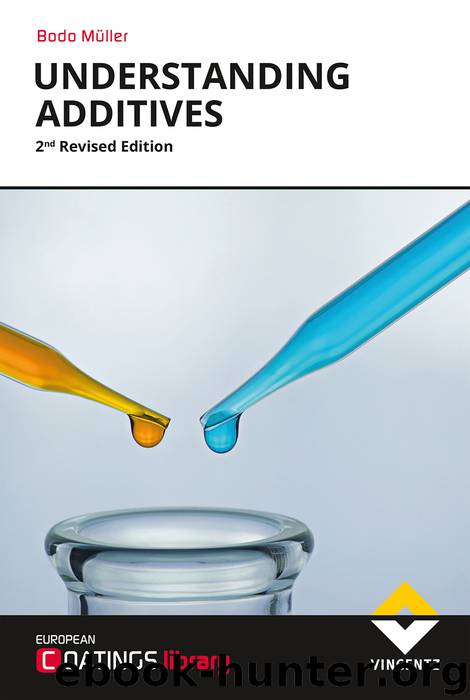Understanding Additives by Bodo Müller

Author:Bodo Müller
Language: eng
Format: epub
Publisher: Vincentz Network
Published: 2019-09-05T16:00:00+00:00
Figure 5.2: Formation and decomposition of hydroperoxides
Driers are metal salts of long-chain organic acids (metal soaps) that are soluble in organic solvents. Driers are added to oxidatively curing paints to accelerate the crosslinking reaction (solidify the coating). The organic acids necessary for salt formation are either naturally occurring fatty acids or synthetic carboxylic acids, such as naphthenic acids (see Figure 1.31) and 2-ethylhexanoic acid. The effect of driers is to decompose hydroperoxides to free-radicals at ambient temperature (Figure 5.2). Especially effective are salts of metals capable of forming two or more oxidation states [e.g. Co(II)/Co(III), Mn(II)/Mn(III)/Mn(IV) or Ce(III)/ Ce(IV)] and thus acting as redox catalysts; they are also called surface driers. The most important redox catalyst is cobalt, whose mode of action is shown in Figure 5.3.
In the first step, cobalt(II) is oxidised to cobalt(III) while in the second step cobalt(III) is reduced to cobalt(II); i.e. cobalt(II) is not consumed and thus is a true catalyst. Nowadays, the use of cobalt compounds is becoming more and more controversial due to possible toxicological effects. Cobalt-free driers are already available on the market.
However, metal salts which form only one oxidation state [e.g. Ca(II), Ba(II), Zn(II) or Zr(IV)] serve as driers, too. These have a weak catalytic effect, if any, when used alone; but they can enhance the effect of redox catalysts. This group of driers can be divided into “through-driers” (or “coordination driers”) and “auxiliary driers” (Table 5.1) [4]. “Auxiliary driers” probably derive their effect (enhancement of the action of redox catalysts) from their Lewis acid character (see Friedel-Crafts catalysts).
The mode of action of “through driers” (or “coordination driers”) is shown in Figure 5.4. The metal ions link paint resin molecules together by salt formation in a manner akin to ionomer crosslinking. Thus, “through-driers” are not true catalysts, as they are consumed.
Oxidative curing accelerated by driers never comes to an end but becomes progressively slower. In the long term, excessive crosslinking may cause embrittlement (see also Chapter 8.2.3). At some stage, embrittlement leads to cracking, as shown in Figure 5.5.
Download
This site does not store any files on its server. We only index and link to content provided by other sites. Please contact the content providers to delete copyright contents if any and email us, we'll remove relevant links or contents immediately.
| Concrete | Extraction & Processing |
| Fracture Mechanics | Materials Science |
| Metallurgy | Polymers & Textiles |
| Strength of Materials | Testing |
Whiskies Galore by Ian Buxton(40299)
Introduction to Aircraft Design (Cambridge Aerospace Series) by John P. Fielding(32331)
Small Unmanned Fixed-wing Aircraft Design by Andrew J. Keane Andras Sobester James P. Scanlan & András Sóbester & James P. Scanlan(32136)
Craft Beer for the Homebrewer by Michael Agnew(17439)
Turbulence by E. J. Noyes(7032)
The Complete Stick Figure Physics Tutorials by Allen Sarah(6631)
Kaplan MCAT General Chemistry Review by Kaplan(6044)
The Thirst by Nesbo Jo(5778)
Bad Blood by John Carreyrou(5762)
Learning SQL by Alan Beaulieu(5399)
Weapons of Math Destruction by Cathy O'Neil(5031)
Man-made Catastrophes and Risk Information Concealment by Dmitry Chernov & Didier Sornette(4728)
iGen by Jean M. Twenge(4694)
Digital Minimalism by Cal Newport;(4511)
Life 3.0: Being Human in the Age of Artificial Intelligence by Tegmark Max(4494)
Audition by Ryu Murakami(4091)
1,001 ASVAB Practice Questions For Dummies by Powers Rod(4034)
Electronic Devices & Circuits by Jacob Millman & Christos C. Halkias(4021)
Pale Blue Dot by Carl Sagan(3996)
